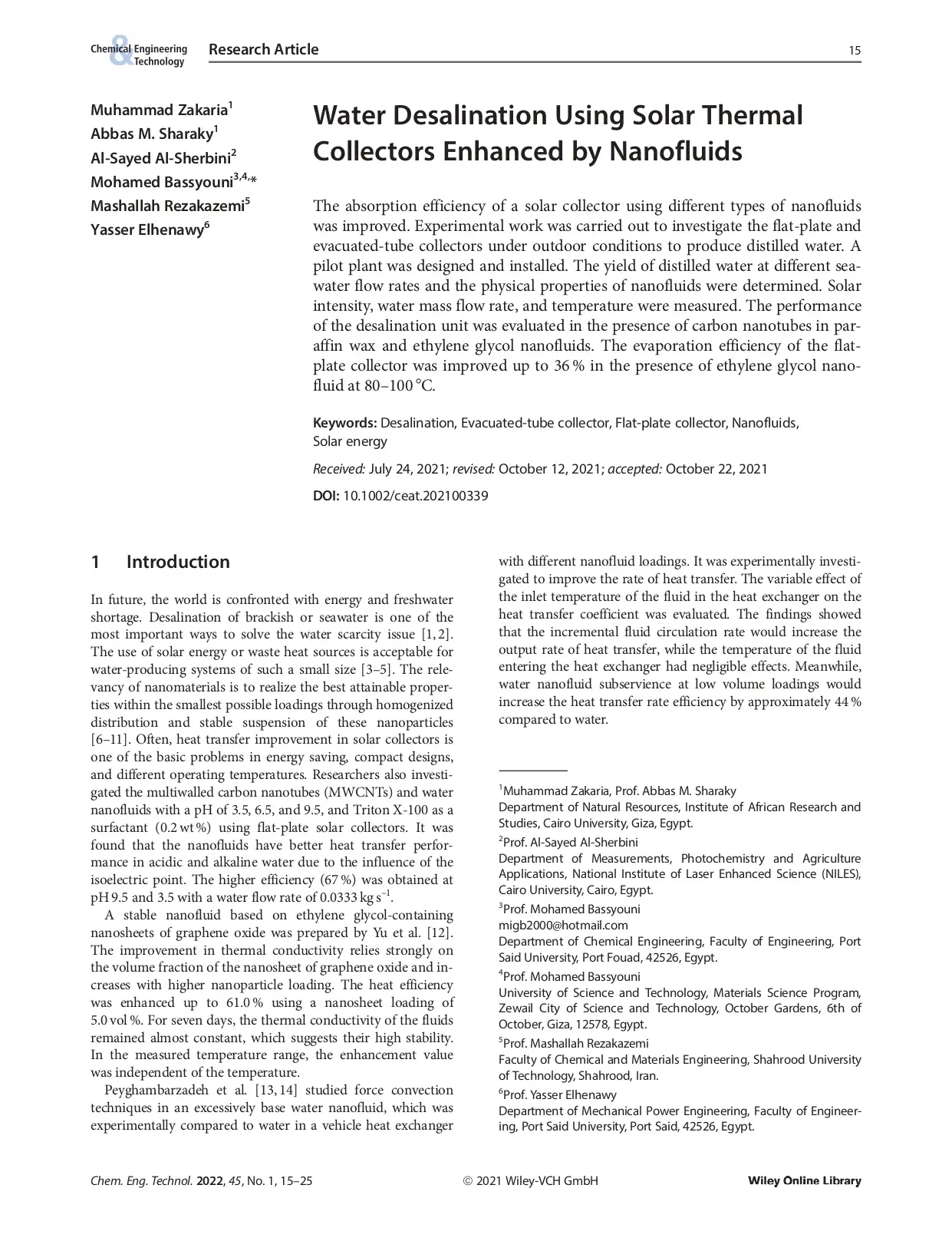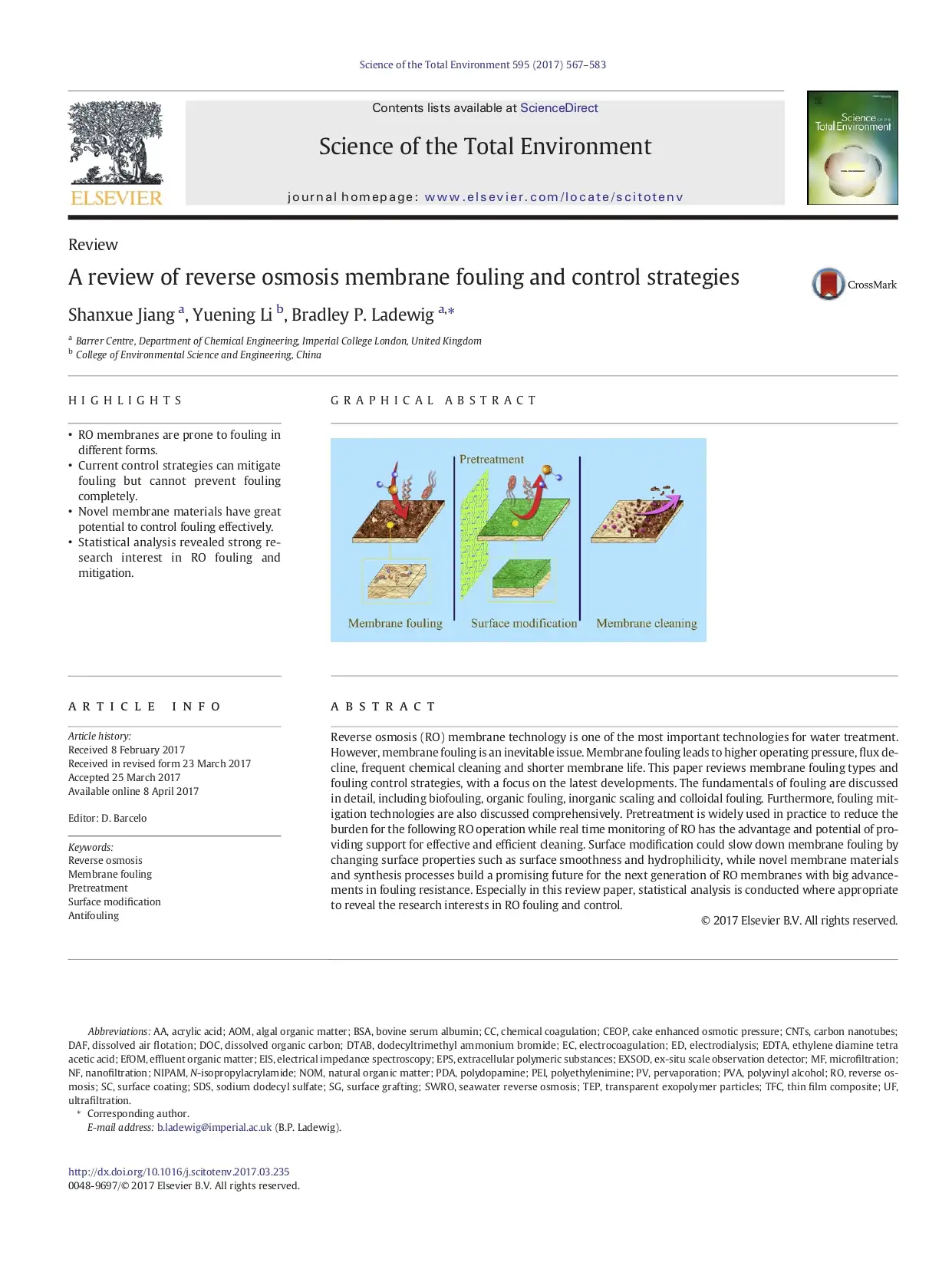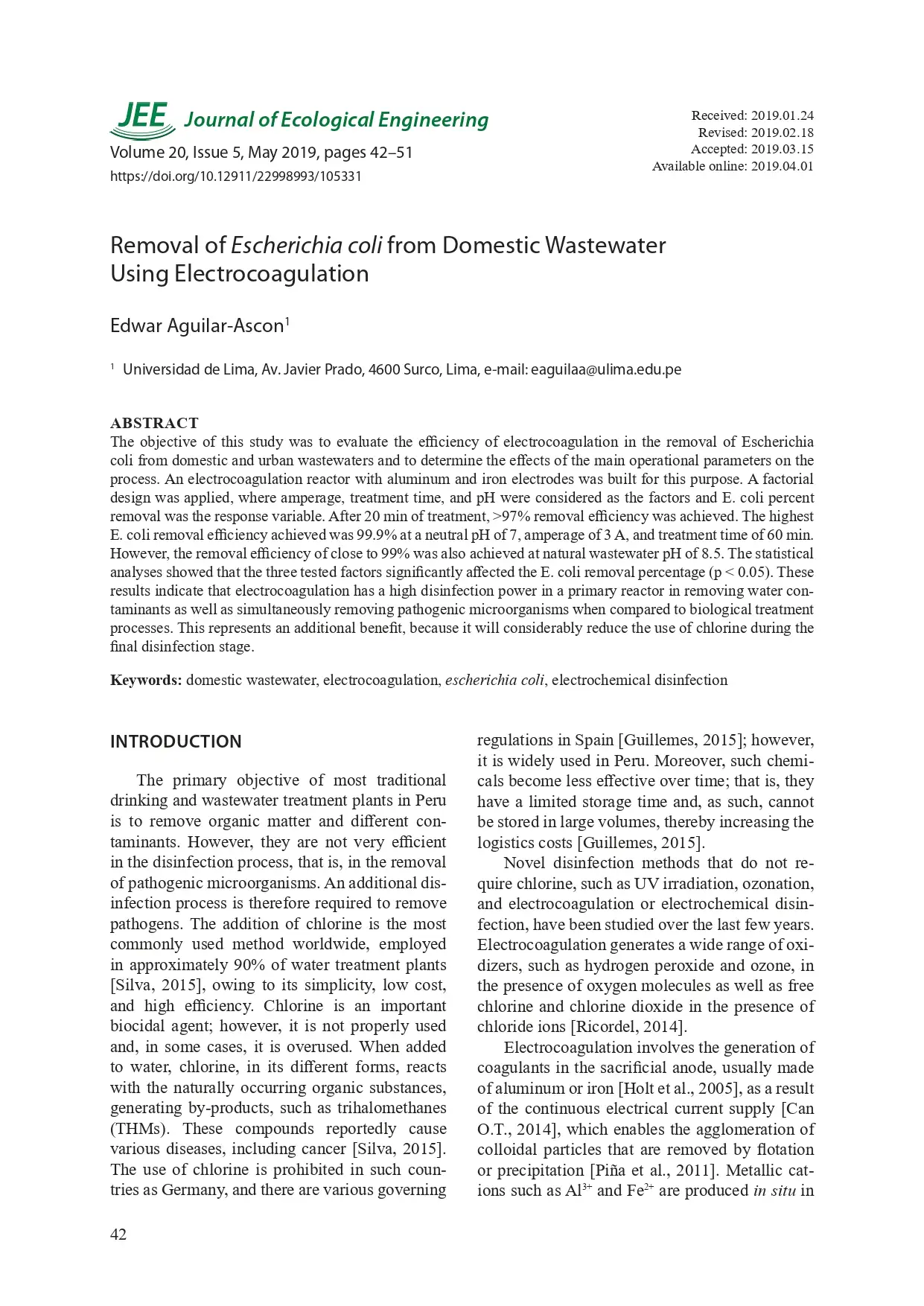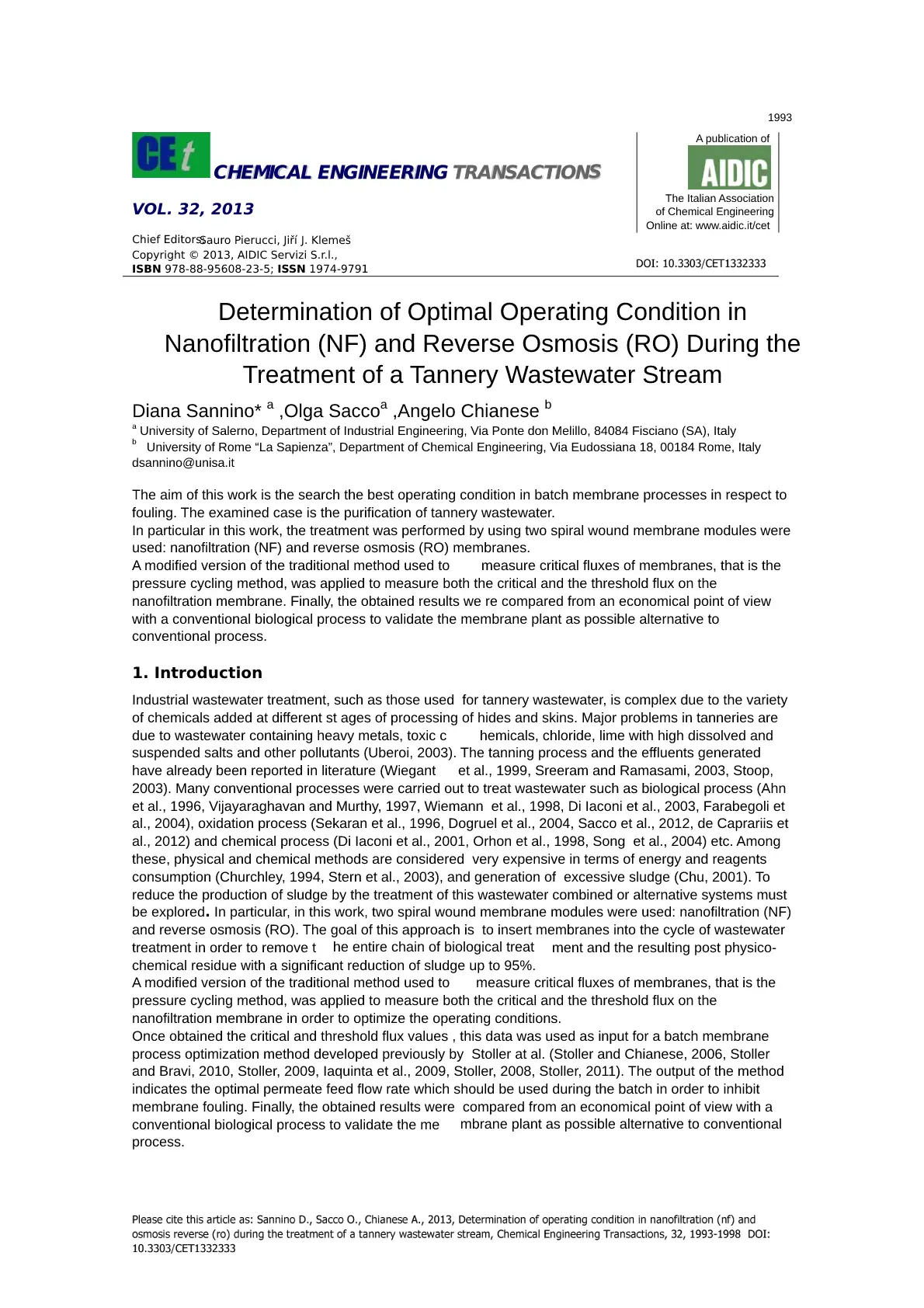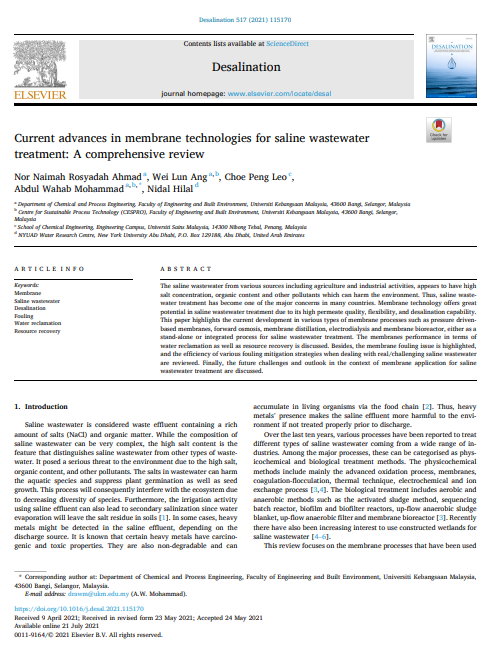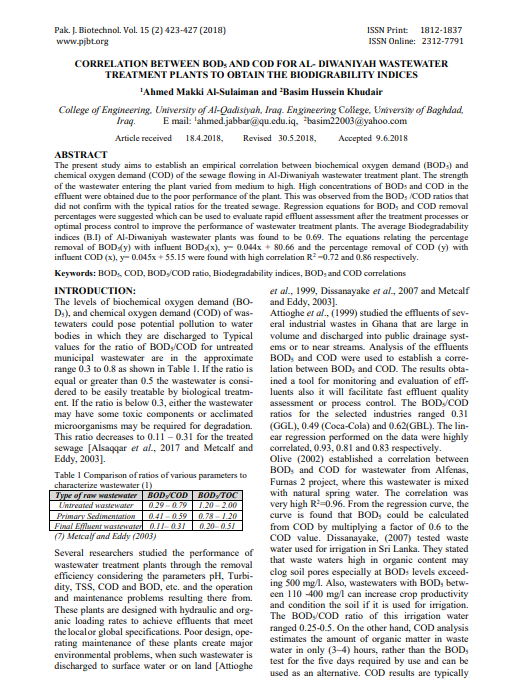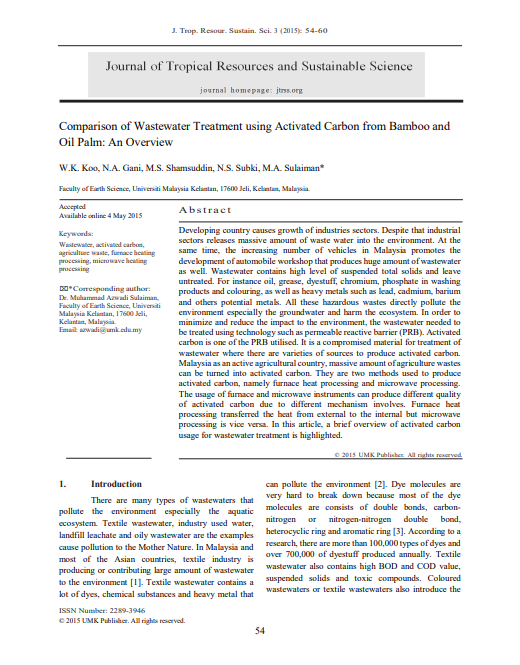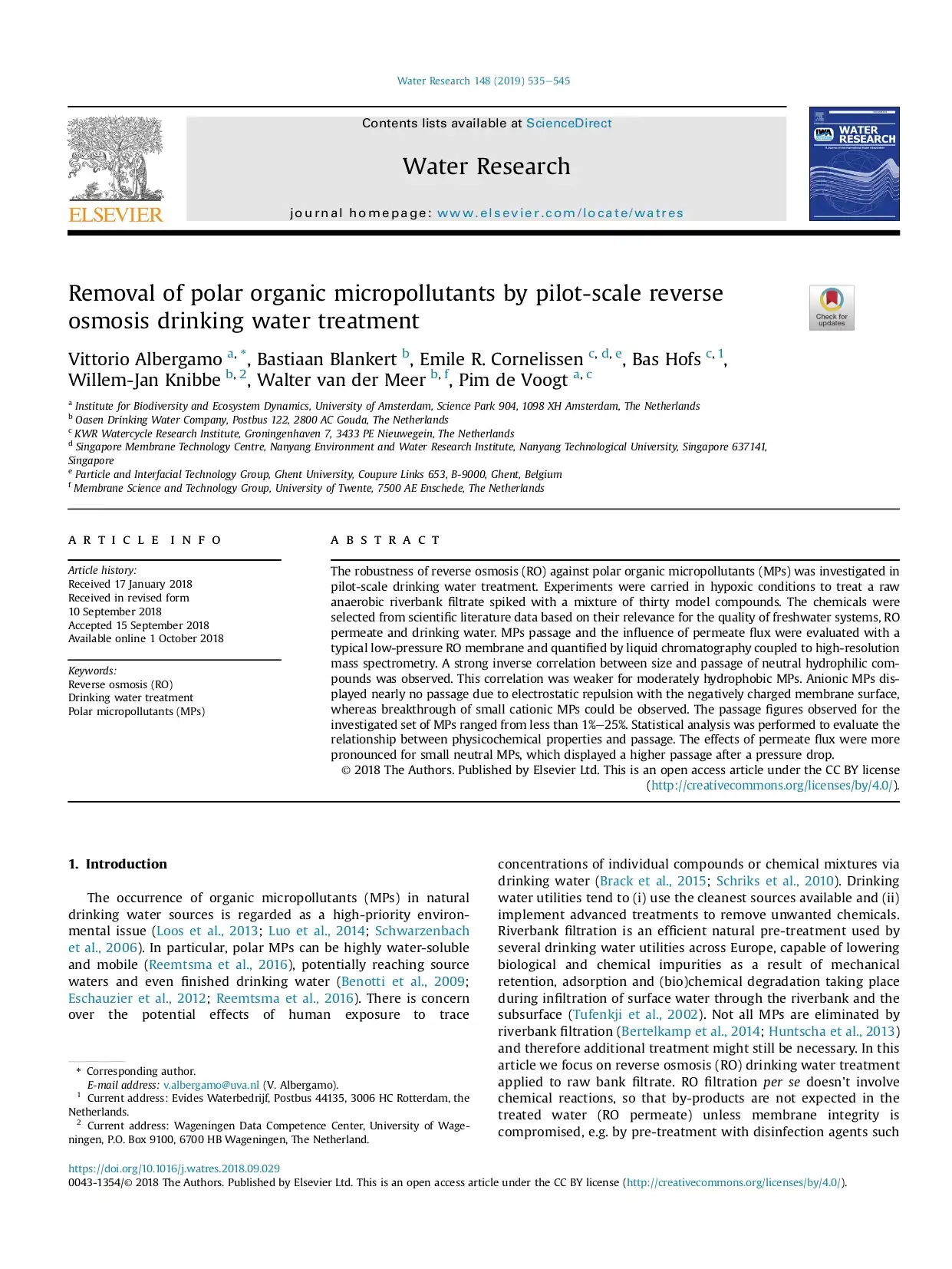Water Desalination Using Solar Thermal Collectors Enhanced by Nanofluids
Introduction
In the future, the world is confronted with energy and freshwater shortage. Desalination of brackish or seawater is one of the most important ways to solve the water scarcity issue [1, 2]. The use of solar energy or waste heat sources is acceptable for water-producing systems of such a small size [3–5]. The relevancy of nanomaterials is to realize the best attainable properties within the smallest possible loadings through homogenized distribution and stable suspension of these nanoparticles[6–11]. Often, heat transfer improvement in solar collectors is one of the basic problems in energy saving, compact designs, and different operating temperatures. Researchers also investigated the multiwalled carbon nanotubes (MWCNTs) and water nanofluids with a pH of 3.5, 6.5, and 9.5, and Triton X-100 as a surfactant (0.2 wt %) using flat-plate solar collectors. It was found that the nanofluids have better heat transfer performance in acidic and alkaline water due to the influence of the isoelectric point. The higher efficiency (67 %) was obtained at pH 9.5 and 3.5 with a water flow rate of 0.0333 kg s–1. A stable nanofluid based on ethylene glycol-containing nanosheets of graphene oxide was prepared by Yu et al. [12]. The improvement in thermal conductivity relies strongly on the volume fraction of the nanosheet of graphene oxide and increases with higher nanoparticle loading. The heat efficiency was enhanced up to 61.0 % using a nanosheet loading of 5.0 vol %. For seven days, the thermal conductivity of the fluids remained almost constant, which suggests their high stability. In the measured temperature range, the enhancement value was independent of the temperature. Peyghambarzadeh et al. [13, 14] studied force convection techniques in an excessively base water nanofluid, which was experimentally compared to water in a vehicle heat exchanger with different nanofluid loadings. It was experimentally investigated to improve the rate of heat transfer. The variable effect of the inlet temperature of the fluid in the heat exchanger on the heat transfer coefficient was evaluated. The findings showed that the incremental fluid circulation rate would increase the output rate of heat transfer, while the temperature of the fluid entering the heat exchanger had negligible effects. Meanwhile, water nanofluid subservience at low-volume loadings would increase the heat transfer rate efficiency by approximately 44 % compared to water
Water Desalination Using Solar Thermal Collectors Enhanced by Nanofluids
Introduction
In the future, the world is confronted with energy and freshwater shortage. Desalination of brackish or seawater is one of the most important ways to solve the water scarcity issue [1, 2]. The use of solar energy or waste heat sources is acceptable for water-producing systems of such a small size [3–5]. The relevancy of nanomaterials is to realize the best attainable properties within the smallest possible loadings through homogenized distribution and stable suspension of these nanoparticles[6–11]. Often, heat transfer improvement in solar collectors is one of the basic problems in energy saving, compact designs, and different operating temperatures. Researchers also investigated the multiwalled carbon nanotubes (MWCNTs) and water nanofluids with a pH of 3.5, 6.5, and 9.5, and Triton X-100 as a surfactant (0.2 wt %) using flat-plate solar collectors. It was found that the nanofluids have better heat transfer performance in acidic and alkaline water due to the influence of the isoelectric point. The higher efficiency (67 %) was obtained at pH 9.5 and 3.5 with a water flow rate of 0.0333 kg s–1. A stable nanofluid based on ethylene glycol-containing nanosheets of graphene oxide was prepared by Yu et al. [12]. The improvement in thermal conductivity relies strongly on the volume fraction of the nanosheet of graphene oxide and increases with higher nanoparticle loading. The heat efficiency was enhanced up to 61.0 % using a nanosheet loading of 5.0 vol %. For seven days, the thermal conductivity of the fluids remained almost constant, which suggests their high stability. In the measured temperature range, the enhancement value was independent of the temperature. Peyghambarzadeh et al. [13, 14] studied force convection techniques in an excessively base water nanofluid, which was experimentally compared to water in a vehicle heat exchanger with different nanofluid loadings. It was experimentally investigated to improve the rate of heat transfer. The variable effect of the inlet temperature of the fluid in the heat exchanger on the heat transfer coefficient was evaluated. The findings showed that the incremental fluid circulation rate would increase the output rate of heat transfer, while the temperature of the fluid entering the heat exchanger had negligible effects. Meanwhile, water nanofluid subservience at low-volume loadings would increase the heat transfer rate efficiency by approximately 44 % compared to water
A Review of Reverse Osmosis Membrane Fouling and Control Strategies
Introduction
This paper reviews membrane contamination and dirt Control strategies, focusing on the latest developments.
The first goal From this paper is to illustrate the types of dirt.
The second goal is To discuss the latest pollution mitigation strategies, including pre-treatment, monitoring, cleaning, and surface modification as well as updates.
A Review of Reverse Osmosis Membrane Fouling and Control Strategies
Introduction
This paper reviews membrane contamination and dirt Control strategies, focusing on the latest developments.
The first goal From this paper is to illustrate the types of dirt.
The second goal is To discuss the latest pollution mitigation strategies, including pre-treatment, monitoring, cleaning, and surface modification as well as updates.
Removal of Escherichia Coli from Domestic Wastewater Using Electrocoagulation
ABSTRACT
The objective of this study was to evaluate the efficiency of electrocoagulation in the removal of Escherichia coli from domestic and urban wastewaters and to determine the effects of the main operational parameters on the process. An electrocoagulation reactor with aluminum and iron electrodes was built for this purpose. A factorial design was applied, where amperage, treatment time, and pH were considered as the factors and E. coli percent removal was the response variable. After 20 min of treatment, >97% removal efficiency was achieved. The highest E. coli removal efficiency achieved was 99.9% at a neutral pH of 7, amperage of 3 A, and treatment time of 60 min. However, the removal efficiency of close to 99% was also achieved at natural wastewater pH of 8.5. The statistical analyses showed that the three tested factors significantly affected the E. coli removal percentage (p < 0.05). These results indicate that electrocoagulation has a high disinfection power in a primary reactor in removing water con[1]taminants as well as simultaneously removing pathogenic microorganisms when compared to biological treatment processes. This represents an additional benefit, because it will considerably reduce the use of chlorine during the final disinfection stage.
Removal of Escherichia Coli from Domestic Wastewater Using Electrocoagulation
ABSTRACT
The objective of this study was to evaluate the efficiency of electrocoagulation in the removal of Escherichia coli from domestic and urban wastewaters and to determine the effects of the main operational parameters on the process. An electrocoagulation reactor with aluminum and iron electrodes was built for this purpose. A factorial design was applied, where amperage, treatment time, and pH were considered as the factors and E. coli percent removal was the response variable. After 20 min of treatment, >97% removal efficiency was achieved. The highest E. coli removal efficiency achieved was 99.9% at a neutral pH of 7, amperage of 3 A, and treatment time of 60 min. However, the removal efficiency of close to 99% was also achieved at natural wastewater pH of 8.5. The statistical analyses showed that the three tested factors significantly affected the E. coli removal percentage (p < 0.05). These results indicate that electrocoagulation has a high disinfection power in a primary reactor in removing water con[1]taminants as well as simultaneously removing pathogenic microorganisms when compared to biological treatment processes. This represents an additional benefit, because it will considerably reduce the use of chlorine during the final disinfection stage.
Determination of Optimal Operating Condition in Nanofiltration (NF) and Reverse Osmosis (RO) During The Treatment of a Tannery Wastewater Stream
Introduction
Industrial wastewater treatment, such as those used for tannery wastewater, is complex due to the variety of chemicals added at different stages of processing of hides and skins. Major problems in tanneries are due to wastewater containing heavy metals, toxic chemicals, chloride, lime with high dissolved and suspended salts and other pollutants (Uberoi, 2003). The tanning process and the effluents generated have already been reported in literature (Wiegant et al., 1999, Sreeram and Ramasami, 2003, Stoop, 2003). Many conventional processes were carried out to treat wastewater such as biological process (Ahn et al., 1996, Vijayaraghavan and Murthy, 1997, Wiemann et al., 1998, Di Iaconi et al., 2003, Farabegoli et al., 2004), oxidation process (Sekaran et al., 1996, Dogruel et al., 2004, Sacco et al., 2012, de Caprariis et al., 2012) and chemical process (Di Iaconi et al., 2001, Orhon et al., 1998, Song et al., 2004) etc. Among these, physical and chemical methods are considered very expensive in terms of energy and reagents consumption (Churchley, 1994, Stern et al., 2003), and generation of excessive sludge (Chu, 2001). To reduce the production of sludge by the treatment of this wastewater combined or alternative systems must be explored. In particular, in this work, two spiral wound membrane modules were used: nanofiltration (NF) and reverse osmosis (RO). The goal of this approach is to insert membranes into the cycle of wastewater treatment in order to remove the entire chain of biological treatment and the resulting post physico[1]chemical residue with a significant reduction of sludge up to 95%. A modified version of the traditional method used to measure critical fluxes of membranes, that is the pressure cycling method, was applied to measure both the critical and the threshold flux on the nanofiltration membrane in order to optimize the operating conditions. Once obtained the critical and threshold flux values, this data was used as input for a batch membrane process optimization method developed previously by Stoller at al. (Stoller and Chianese, 2006, Stoller and Bravi, 2010, Stoller, 2009, Iaquinta et al., 2009, Stoller, 2008, Stoller, 2011). The output of the method indicates the optimal permeate feed flow rate which should be used during the batch in order to inhibit membrane fouling. Finally, the obtained results were compared from an economical point of view with a conventional biological process to validate the membrane plant as possible alternative to conventional process.
Determination of Optimal Operating Condition in Nanofiltration (NF) and Reverse Osmosis (RO) During The Treatment of a Tannery Wastewater Stream
Introduction
Industrial wastewater treatment, such as those used for tannery wastewater, is complex due to the variety of chemicals added at different stages of processing of hides and skins. Major problems in tanneries are due to wastewater containing heavy metals, toxic chemicals, chloride, lime with high dissolved and suspended salts and other pollutants (Uberoi, 2003). The tanning process and the effluents generated have already been reported in literature (Wiegant et al., 1999, Sreeram and Ramasami, 2003, Stoop, 2003). Many conventional processes were carried out to treat wastewater such as biological process (Ahn et al., 1996, Vijayaraghavan and Murthy, 1997, Wiemann et al., 1998, Di Iaconi et al., 2003, Farabegoli et al., 2004), oxidation process (Sekaran et al., 1996, Dogruel et al., 2004, Sacco et al., 2012, de Caprariis et al., 2012) and chemical process (Di Iaconi et al., 2001, Orhon et al., 1998, Song et al., 2004) etc. Among these, physical and chemical methods are considered very expensive in terms of energy and reagents consumption (Churchley, 1994, Stern et al., 2003), and generation of excessive sludge (Chu, 2001). To reduce the production of sludge by the treatment of this wastewater combined or alternative systems must be explored. In particular, in this work, two spiral wound membrane modules were used: nanofiltration (NF) and reverse osmosis (RO). The goal of this approach is to insert membranes into the cycle of wastewater treatment in order to remove the entire chain of biological treatment and the resulting post physico[1]chemical residue with a significant reduction of sludge up to 95%. A modified version of the traditional method used to measure critical fluxes of membranes, that is the pressure cycling method, was applied to measure both the critical and the threshold flux on the nanofiltration membrane in order to optimize the operating conditions. Once obtained the critical and threshold flux values, this data was used as input for a batch membrane process optimization method developed previously by Stoller at al. (Stoller and Chianese, 2006, Stoller and Bravi, 2010, Stoller, 2009, Iaquinta et al., 2009, Stoller, 2008, Stoller, 2011). The output of the method indicates the optimal permeate feed flow rate which should be used during the batch in order to inhibit membrane fouling. Finally, the obtained results were compared from an economical point of view with a conventional biological process to validate the membrane plant as possible alternative to conventional process.
Current Advances in Membrane Technologies for Saline Wastewater Treatment A Comprehensive Review
ABSTRACT
The saline wastewater from various sources including agriculture and industrial activities, appears to have high salt concentration, organic content and other pollutants which can harm the environment. Thus, saline waste[1]water treatment has become one of the major concerns in many countries. Membrane technology offers great potential in saline wastewater treatment due to its high permeate quality, flexibility, and desalination capability. This paper highlights the current development in various types of membrane processes such as pressure driven[1]based membranes, forward osmosis, membrane distillation, electrodialysis and membrane bioreactor, either as a stand-alone or integrated process for saline wastewater treatment. The membranes performance in terms of water reclamation as well as resource recovery is discussed. Besides, the membrane fouling issue is highlighted, and the efficiency of various fouling mitigation strategies when dealing with real/challenging saline wastewater are reviewed. Finally, the future challenges and outlook in the context of membrane application for saline wastewater treatment are discussed.
Current Advances in Membrane Technologies for Saline Wastewater Treatment A Comprehensive Review
ABSTRACT
The saline wastewater from various sources including agriculture and industrial activities, appears to have high salt concentration, organic content and other pollutants which can harm the environment. Thus, saline waste[1]water treatment has become one of the major concerns in many countries. Membrane technology offers great potential in saline wastewater treatment due to its high permeate quality, flexibility, and desalination capability. This paper highlights the current development in various types of membrane processes such as pressure driven[1]based membranes, forward osmosis, membrane distillation, electrodialysis and membrane bioreactor, either as a stand-alone or integrated process for saline wastewater treatment. The membranes performance in terms of water reclamation as well as resource recovery is discussed. Besides, the membrane fouling issue is highlighted, and the efficiency of various fouling mitigation strategies when dealing with real/challenging saline wastewater are reviewed. Finally, the future challenges and outlook in the context of membrane application for saline wastewater treatment are discussed.
Correlation Between BOD5 and COD for Al- Diwaniyah Wastewater Treatment Plants to Obtain The Biodigrability Indices
ABSTRACT
The present study aims to establish an empirical correlation between biochemical oxygen demand (BOD5) and chemical oxygen demand (COD) of the sewage flowing in Al-Diwaniyah wastewater treatment plant. The strength of the wastewater entering the plant varied from medium to high. High concentrations of BOD5 and COD in the effluent were obtained due to the poor performance of the plant. This was observed from the BOD5 /COD ratios that did not confirm with the typical ratios for the treated sewage. Regression equations for BOD5 and COD removal percentages were suggested which can be used to evaluate rapid effluent assessment after the treatment processes or optimal process control to improve the performance of wastewater treatment plants. The average Biodegradability indices (B.I) of Al-Diwaniyah wastewater plants was found to be 0.69. The equations relating the percentage removal of BOD5(y) with influent BOD5(x), y= 0.044x + 80.66 and the percentage removal of COD (y) with influent COD (x), y= 0.045x + 55.15 were found with high correlation R2 =0.72 and 0.86 respectively. Keywords: BOD5, COD, BOD5/COD ratio, Biodegradability indices, BOD5 and COD correlations
Correlation Between BOD5 and COD for Al- Diwaniyah Wastewater Treatment Plants to Obtain The Biodigrability Indices
ABSTRACT
The present study aims to establish an empirical correlation between biochemical oxygen demand (BOD5) and chemical oxygen demand (COD) of the sewage flowing in Al-Diwaniyah wastewater treatment plant. The strength of the wastewater entering the plant varied from medium to high. High concentrations of BOD5 and COD in the effluent were obtained due to the poor performance of the plant. This was observed from the BOD5 /COD ratios that did not confirm with the typical ratios for the treated sewage. Regression equations for BOD5 and COD removal percentages were suggested which can be used to evaluate rapid effluent assessment after the treatment processes or optimal process control to improve the performance of wastewater treatment plants. The average Biodegradability indices (B.I) of Al-Diwaniyah wastewater plants was found to be 0.69. The equations relating the percentage removal of BOD5(y) with influent BOD5(x), y= 0.044x + 80.66 and the percentage removal of COD (y) with influent COD (x), y= 0.045x + 55.15 were found with high correlation R2 =0.72 and 0.86 respectively. Keywords: BOD5, COD, BOD5/COD ratio, Biodegradability indices, BOD5 and COD correlations
Correlating BOD5 and COD of Sewage in Wastewater Treatment Plants Case Study Al- Diwaniyah WWTP in Iraq
ABSTRACT
This study aims to establish an empirical correlation between biochemical oxygen demand (BOD5) and chemical oxygen demand (COD) of the sewage flowing in Al-Diwaniyah wastewater treatment plant. The strength of the wastewater entering the plant varied from medium to high. High concentrations of BOD5 and COD in the effluent were obtained due to the poor performance of the plant. This was observed from the BOD5 /COD ratios that did not confirm with the typical ratios for the treated sewage. To improve the performance of this plant, regression equations for BOD5 and COD removal percentages were suggested which can be used to facilitate rapid effluent assessment or optimal process control. The equations relating the percentage removal of BOD5(y) with influent BOD5(x), y= 0.044x + 80.66 and the percentage removal of COD (y) with influent COD (x), y= 0.045x + 55.15 were found with high correlation R2 =0.72 and 0.86 respectively. Key words: Sewage treatment, BOD5, COD, BOD5/COD ratio, BOD5&COD correlations
Correlating BOD5 and COD of Sewage in Wastewater Treatment Plants Case Study Al- Diwaniyah WWTP in Iraq
ABSTRACT
This study aims to establish an empirical correlation between biochemical oxygen demand (BOD5) and chemical oxygen demand (COD) of the sewage flowing in Al-Diwaniyah wastewater treatment plant. The strength of the wastewater entering the plant varied from medium to high. High concentrations of BOD5 and COD in the effluent were obtained due to the poor performance of the plant. This was observed from the BOD5 /COD ratios that did not confirm with the typical ratios for the treated sewage. To improve the performance of this plant, regression equations for BOD5 and COD removal percentages were suggested which can be used to facilitate rapid effluent assessment or optimal process control. The equations relating the percentage removal of BOD5(y) with influent BOD5(x), y= 0.044x + 80.66 and the percentage removal of COD (y) with influent COD (x), y= 0.045x + 55.15 were found with high correlation R2 =0.72 and 0.86 respectively. Key words: Sewage treatment, BOD5, COD, BOD5/COD ratio, BOD5&COD correlations
Comparison of Wastewater Treatment Using Activated Carbon from Bamboo and Oil Palm
Abstract
Developing country causes growth of industries sectors. Despite that industrial sectors releases massive amount of waste water into the environment. At the same time, the increasing number of vehicles in Malaysia promotes the development of automobile workshop that produces huge amount of wastewater as well. Wastewater contains high level of suspended total solids and leave untreated. For instance oil, grease, dyestuff, chromium, phosphate in washing products and colouring, as well as heavy metals such as lead, cadmium, barium and others potential metals. All these hazardous wastes directly pollute the environment especially the groundwater and harm the ecosystem. In order to minimize and reduce the impact to the environment, the wastewater needed to be treated using technology such as permeable reactive barrier (PRB). Activated carbon is one of the PRB utilised. It is a compromised material for treatment of wastewater where there are varieties of sources to produce activated carbon. Malaysia as an active agricultural country, massive amount of agriculture wastes can be turned into activated carbon. They are two methods used to produce activated carbon, namely furnace heat processing and microwave processing. The usage of furnace and microwave instruments can produce different quality of activated carbon due to different mechanism involves. Furnace heat processing transferred the heat from external to the internal but microwave processing is vice versa. In this article, a brief overview of activated carbon usage for wastewater treatment is highlighted.
Comparison of Wastewater Treatment Using Activated Carbon from Bamboo and Oil Palm
Abstract
Developing country causes growth of industries sectors. Despite that industrial sectors releases massive amount of waste water into the environment. At the same time, the increasing number of vehicles in Malaysia promotes the development of automobile workshop that produces huge amount of wastewater as well. Wastewater contains high level of suspended total solids and leave untreated. For instance oil, grease, dyestuff, chromium, phosphate in washing products and colouring, as well as heavy metals such as lead, cadmium, barium and others potential metals. All these hazardous wastes directly pollute the environment especially the groundwater and harm the ecosystem. In order to minimize and reduce the impact to the environment, the wastewater needed to be treated using technology such as permeable reactive barrier (PRB). Activated carbon is one of the PRB utilised. It is a compromised material for treatment of wastewater where there are varieties of sources to produce activated carbon. Malaysia as an active agricultural country, massive amount of agriculture wastes can be turned into activated carbon. They are two methods used to produce activated carbon, namely furnace heat processing and microwave processing. The usage of furnace and microwave instruments can produce different quality of activated carbon due to different mechanism involves. Furnace heat processing transferred the heat from external to the internal but microwave processing is vice versa. In this article, a brief overview of activated carbon usage for wastewater treatment is highlighted.
Removal Of Polar Organic Micropollutants By Pilot-Scale Reverse Osmosis Drinking Water Treatment
Abstract : The robustness of reverse osmosis (RO) against polar organic micropollutants (MPs) was investigated in
pilot-scale drinking water treatment. Experiments were carried in hypoxic conditions to treat a raw anaerobic riverbank filtrate spiked with a mixture of thirty model compounds. The chemicals were selected from scientific literature data based on their relevance for the quality of freshwater systems, RO permeate and drinking water. MPs passage and the influence of permeate flux were evaluated with a typical low-pressure RO membrane and quantified by liquid chromatography coupled to high-resolution mass spectrometry. A strong inverse correlation between size and passage of neutral hydrophilic compounds was observed. This correlation was weaker for moderately hydrophobic MPs. Anionic MPs displayed nearly no passage due to electrostatic repulsion with the negatively charged membrane surface,
whereas breakthrough of small cationic MPs could be observed. The passage figures observed for the investigated set of MPs ranged from less than 1%e25%. Statistical analysis was performed to evaluate the relationship between physicochemical properties and passage. The effects of permeate flux were more pronounced for small neutral MPs, which displayed a higher passage after a pressure drop.
Removal Of Polar Organic Micropollutants By Pilot-Scale Reverse Osmosis Drinking Water Treatment
Abstract : The robustness of reverse osmosis (RO) against polar organic micropollutants (MPs) was investigated in
pilot-scale drinking water treatment. Experiments were carried in hypoxic conditions to treat a raw anaerobic riverbank filtrate spiked with a mixture of thirty model compounds. The chemicals were selected from scientific literature data based on their relevance for the quality of freshwater systems, RO permeate and drinking water. MPs passage and the influence of permeate flux were evaluated with a typical low-pressure RO membrane and quantified by liquid chromatography coupled to high-resolution mass spectrometry. A strong inverse correlation between size and passage of neutral hydrophilic compounds was observed. This correlation was weaker for moderately hydrophobic MPs. Anionic MPs displayed nearly no passage due to electrostatic repulsion with the negatively charged membrane surface,
whereas breakthrough of small cationic MPs could be observed. The passage figures observed for the investigated set of MPs ranged from less than 1%e25%. Statistical analysis was performed to evaluate the relationship between physicochemical properties and passage. The effects of permeate flux were more pronounced for small neutral MPs, which displayed a higher passage after a pressure drop.


